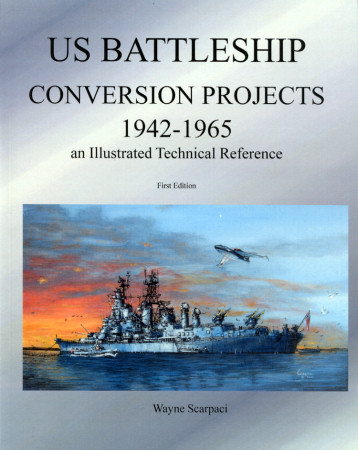
US Battleship Conversion Projects 1942–1965: An Illustrated Technical Reference Book Review
By David L. Veres
| Date of Review | February 2014 | Title | US Battleship Conversion Projects 1942–1965: An Illustrated Technical Reference |
|---|---|---|---|
| Author | Wayne Scarpaci | Publisher | CreateSpace Independent Publishing Platform |
| Published | 2013 | ISBN | 9781475099508 |
| Format | 118 pages, softbound | MSRP (USD) | $33.99 |
Book Review
Here's a cool, counterfactual compendium for US warship enthusiasts and "what if" modelers.
US Battleship Conversion Projects 1942–1965 recaps a wondrous array of modification plans and proposals – chiefly to American "third-generation" vessels.
Subtitled "An Illustrated Technical Reference", coverage begins with an author's forward, general introduction, and overview of the ten third-generation battleships.
Contents then segue to 32 pages on US Navy missile development – surface-to-surface, surface-to-air and anti-submarine weapons.
That lays the groundwork for the bulk of the book – conversion projects of six capital ship classes:
- Iowa
- Alaska
- South Dakota
- North Carolina
- Colorado
- New Mexico
Organized chronologically by ship type and hull number, the volume explores aircraft carrier conversions, hybrid designs, missile-launch platforms, amphibious operations support ships, replenishment vessels, training assets and other projects.
While, for instance, Polaris missiles saw extensive deployment on US Navy nuclear submarines, planners gave serious consideration to basing schemes aboard modified battleships. In the end, only one surface ship – surprisingly, the Italian World War II era light cruiser Giuseppe Garibaldi! – operationally carried Polaris weapons.
Note, too, that Alaska-class "Large Cruisers" – qualified as capital ships under the 1922 Washington Naval Treaty – merit major inclusion in author Scarpaci's absorbing account. And those sections proved personal favorites.
But some of history's most intriguing schemes lay outside the author's timeframe. Contents do not cover, for instance, Iowa-class conversion concepts of the 1980s. These include, among others, replacing the aft main turret with twin ski-jump ramps for AV-8 Harriers – the so-called "Phase II" service upgrade – and launching new, smaller "BBL" gunfire-support ships with the redundant 16" armament. Let's hope Scarpaci considers a companion volume on these and other Reagan-era battleship initiatives.
Dozens of 1:1200 scale drawings, the author's excellent, conceptual paintings, and archival images illustrate text. A selected bibliography of secondary sources, three appendices, glossary and index complete contents.
Looking for a fast, fascinating read? Grab this entertaining effort.
Recommended!
My sincere thanks to CreateSpace Independent Publishing Platform for this review sample!







